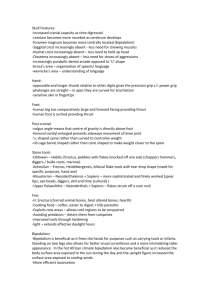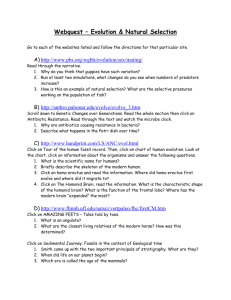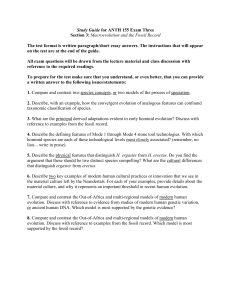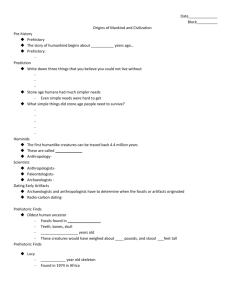laboratory # 4 middle pleistocene hominins
advertisement
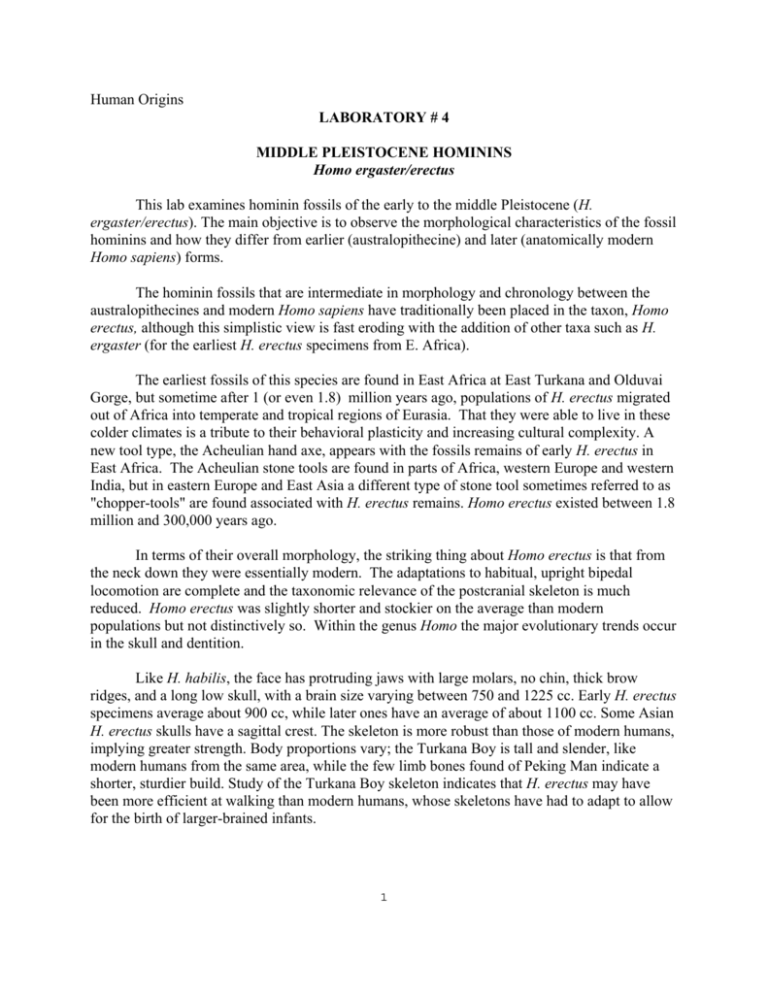
Human Origins LABORATORY # 4 MIDDLE PLEISTOCENE HOMININS Homo ergaster/erectus This lab examines hominin fossils of the early to the middle Pleistocene (H. ergaster/erectus). The main objective is to observe the morphological characteristics of the fossil hominins and how they differ from earlier (australopithecine) and later (anatomically modern Homo sapiens) forms. The hominin fossils that are intermediate in morphology and chronology between the australopithecines and modern Homo sapiens have traditionally been placed in the taxon, Homo erectus, although this simplistic view is fast eroding with the addition of other taxa such as H. ergaster (for the earliest H. erectus specimens from E. Africa). The earliest fossils of this species are found in East Africa at East Turkana and Olduvai Gorge, but sometime after 1 (or even 1.8) million years ago, populations of H. erectus migrated out of Africa into temperate and tropical regions of Eurasia. That they were able to live in these colder climates is a tribute to their behavioral plasticity and increasing cultural complexity. A new tool type, the Acheulian hand axe, appears with the fossils remains of early H. erectus in East Africa. The Acheulian stone tools are found in parts of Africa, western Europe and western India, but in eastern Europe and East Asia a different type of stone tool sometimes referred to as "chopper-tools" are found associated with H. erectus remains. Homo erectus existed between 1.8 million and 300,000 years ago. In terms of their overall morphology, the striking thing about Homo erectus is that from the neck down they were essentially modern. The adaptations to habitual, upright bipedal locomotion are complete and the taxonomic relevance of the postcranial skeleton is much reduced. Homo erectus was slightly shorter and stockier on the average than modern populations but not distinctively so. Within the genus Homo the major evolutionary trends occur in the skull and dentition. Like H. habilis, the face has protruding jaws with large molars, no chin, thick brow ridges, and a long low skull, with a brain size varying between 750 and 1225 cc. Early H. erectus specimens average about 900 cc, while later ones have an average of about 1100 cc. Some Asian H. erectus skulls have a sagittal crest. The skeleton is more robust than those of modern humans, implying greater strength. Body proportions vary; the Turkana Boy is tall and slender, like modern humans from the same area, while the few limb bones found of Peking Man indicate a shorter, sturdier build. Study of the Turkana Boy skeleton indicates that H. erectus may have been more efficient at walking than modern humans, whose skeletons have had to adapt to allow for the birth of larger-brained infants. 1 Homo habilis and all the australopithecines are found only in Africa, but H. erectus was wide-ranging, and has been found in Africa, Asia, and perhaps Europe. There is evidence that H. erectus probably used fire, and their stone tools are more sophisticated than those of H. habilis. Compared to the earlier hominins (especially the australopithecines) the following features characterize Homo erectus: Changes related to brain size: -expanding cranial capacity partly due just to larger average body height and size -differing proportions of crania change in Homo erectus are due to increases in specific areas of the brain (e.g. posterior parietal and frontal lobes of the brain relating to the development of culture) Diet-related changes - reduced size of posterior teeth - less robust mandible - reduction in the structures supporting the chewing muscles (relating to more meat in diet and food preparation) Changes in the cranial buttressing system - larger brow ridges - thicker cranial bones (these possibly due to more anterior tooth use) Morphological features typical of Homo erectus include: - thick bones - long, low skull (platycephaly) - 775-1400 c.c (1100 cc, average) cranial capacity - well developed supraorbital and occipital tori - angulation (lateral view) of occiput - maximum breadth low on temporal bones - prognathous face - no chin (multiple mental foramina) - sloping forehead - slight sagittal keel (not crest) - post-orbital constriction - molar size increase from front to back (or equal) Homo erectus/ergaster Comparisons Although many aspects of Homo ergaster and Homo erectus anatomy are, similar, characteristics that distinguish H. ergaster from H. erectus are a higher cranial vault, thinner cranial bone, absence of a sagittal keel, variation in the cranial base in ergaster. Homo erectus differs from H. ergaster by possessing a long, low cranium, thick cranial bone, and the presence of brow ridges. 2 Exercise 1: Using the specimens of H. erectus and modern H. sapiens provided describe and/or contrast these cranial features. Feature/Specimen H. erectus/ergaster Cranial vault size (capacity) and shape Cranial vault height (platycrania) Supraorbital tori Occiput shape (lateral view) Sagittal crest Post-orbital constriction Forehead (describe) Maximum breadth of cranial vault when viewed posteriorly Face Mandible (chin) 3 Modern H. sapiens EXERCISE 2: Using the specimens of H. erectus fossils provided at this demonstration, compare the dentition of H erectus with modern human specimens that are the differences exhibited by the H. erectus dentitions? EXERCISE 3: Compare the crania of earlier H. erectus specimens from Africa (e.g., KNM 3733) with those of later H erectus specimens. Would you support gradual morphological change, stasis, or something in between for the roughly 1.5 million years represented by these specimens? Support your answer with data and observations using these specimens. EXERCISE 4: Examining the H. erectus and modern human postcranial specimens at this demonstration, what can you conclude about the size and robusticity of H. erectus skeletons and their locomotion? 4
